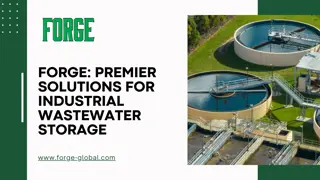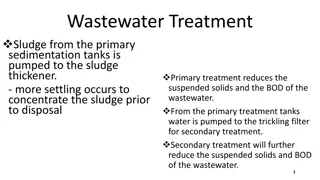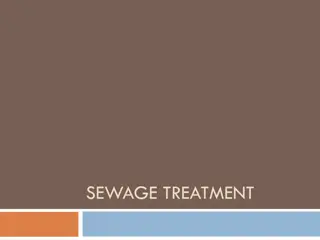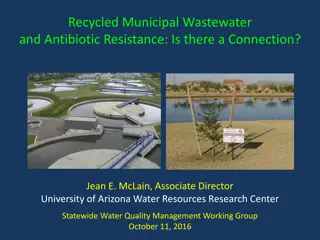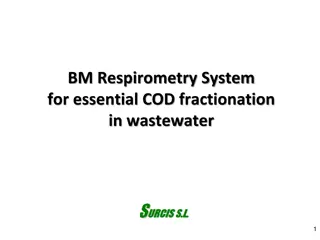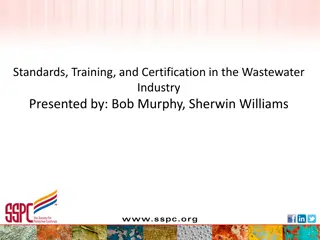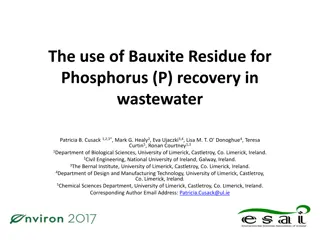Wastewater Treatment: Importance and Process
Wastewater, a byproduct of various water uses, must be treated to remove pollutants and protect the environment and public health. Wastewater treatment plants play a crucial role in cleaning water from home, commercial, and industrial sources through primary, secondary, and tertiary stages, resulting in purified water safe for discharge. Proper treatment prevents waterborne diseases and environmental degradation, making wastewater treatment a necessity for society.
Download Presentation

Please find below an Image/Link to download the presentation.
The content on the website is provided AS IS for your information and personal use only. It may not be sold, licensed, or shared on other websites without obtaining consent from the author.If you encounter any issues during the download, it is possible that the publisher has removed the file from their server.
You are allowed to download the files provided on this website for personal or commercial use, subject to the condition that they are used lawfully. All files are the property of their respective owners.
The content on the website is provided AS IS for your information and personal use only. It may not be sold, licensed, or shared on other websites without obtaining consent from the author.
E N D
Presentation Transcript
What is wastewater? Wastewater or sewage is the byproduct of many uses of water. There are the household uses such as showering, dishwashing, laundry and, of course, flushing the toilet. Additionally, companies use water for many purposes including processes, products, and cleaning or rinsing of parts. After the water has been used, it enters the wastewater stream, and it flows to the wastewater treatment plant. When people visit a treatment plant for the first time, often it is not what they perceived it would be. These wastewater plants are complex facilities and provide a high quality end product
Why treat wastewater? We need to remove the wastewater pollutants to protect the environment and protect public health. When water is used by our society, the water becomes contaminated with pollutants. If left untreated, these pollutants would negatively affect our water environment. For example, organic matter can cause oxygen depletion in lakes, rivers, and streams. This biological decomposition of organics could result in fish kills and/or foul odors. Waterborne diseases are also eliminated through proper wastewater treatment. Additionally, there are many pollutants that could exhibit toxic effects on aquatic life and the public.
Necessity of waste water treatment Wastewater treatment plant plays an important role for the mankind. The main function of these plants is to make the water of the waste water that comes from home, commercial and industrial sectors. The treatment of waste water has become the need of the hour as it stops spreading the diseases and illness caused by the waste water. It helps society in making the water as well as environment clean. The treatment plant works composed of 3. The three stages of these plants include the primary stage, the secondary stage and the tertiary stage.
Necessity of waste water treatment In the primary stage, the contaminants that are easy to eliminate are taken out from the waste water . These substances may include oils, grease and fats that can be easily removed from the surface area. The solids things like grits, stones,rpcks etc are strained. At the secondary stage, the removal of biological contaminants in wastewater takes place. At the tertiary treatment, which is the last stage of the plant, the water is get cleaned purely to get discharged in the environment. This is composed of man-made or artificial systems that help in filtration. At this stage, the nitrogen and phosphorous content is eliminated from the water. In addition to this, the water is further disinfected using chemicals like chlorine as well as treatment of UV. Through these stages, the final water that comes out is clean and free from pollutants that can be safely released to the environment.
Wastewaters are usually classified as industrial and domestic (sewage or munciple wastewater) wastewater Characteristics of industrial wastewater vary greatly from industry to industry and within industries also there are variations in the quality depending upon the processes. Quality of waste water also plays an important role in design and construction of various treatment units.
Water Basics H2O dipole solid, liquid, gas (0 C, 100 C) density (1,000 kg/m3) heat: specific heat 4.18 kj/(kg C); heat of evaporation/enthalpy of vaporization 2,250 kj/kg viscosity: 1.0 mPa.s with 20 contaminants: dissolved (< 10 nm), colloidal (10 nm-1 m), suspended solids (> 1 m) water as a solvent: gases (Henry s Law), liquids (miscibility) ionisation: ions, acids, bases oxidation-reduction
Composition of wastewater Water (more than 95 percent) Pathogens such as bacteria, viruses, prions and parasitic worms Non-pathogenic bacteria Organic particles such as feces, hairs, food, vomit, plant materials, humus etc Soluble organic material such as urea, sugars, soluble proteins, drugs, pharmaceuticals Inorganic particles such as sand, grit, metal particles, ceramics etc
Composition of wastewater Soluble inorganic material such as ammonia,road-salt, sea-salt, cyanide, hydrogen sulfide, thiocyanates, thiosulfates, etc. Animals such as protozoa,insects, small fish, etc. Gases such as hydrogen sulfide, carbon dioxide,methane, etc. Pharmaceuticals and hormones
Characteristics of wastewater The characteristics of sewage can be classified under following three heads: Physical Characteristics Chemical Characteristics Biological Characteristics
Physical Characteristics Colour Odour Temperature Turbidity
Physical Characteristics The Physical Characteristics of wastewater are determined using the physical method of analysis: Colour : The colour of the waste water indicates the freshness of sewage. If it s colour is greyish brown or yellowish, it indicates fresh waste. With passage of time, as putrefaction starts it begins to get black. The colour of stale and septic sewage is black( When all the oxygen has disappeared from waste water, it becomes septic). Other colors may also be formed due to presence of some specific industrial waste. The color of the sewage can normally be detected by the naked eye.
Physical Characteristics Odour: The odour of a fresh waste water is not offensive or practically it can be considered odourless, but as it starts to get stale, it begins to give offensive odour. Within 3 to 4 hours, all oxygen present in the sewage gets exhausted and it starts emitting offensive odour by hydrogen sulphide gas which is formed due to anaerobic decomposition of sewage.
Physical Characteristics Temperature: The temperature has an effect on the biological activity of bacteria present in the sewage and it also affects the solubility of gases in sewage. It also affects the viscosity of sewage (more is the temperature, lesser is the viscosity of sewage). The normal temperature, of sewage is slightly higher than the temperature of the water supply because of the additional heat due to utilization of water. Also when the wastewater flows in a closed pipes, its temperature future increases. The average temperature of sewage in India is about 20 0C which is near about ideal temperature of sewage for biological activities. At higher temperature coupled with the lower dissolved oxygen activities can cause serious problems in disposal of waste water.
Physical Characteristics Turbitidy: Wastewater is normally turbid representing dirty dish water or wastewater from baths having other floating matter like fecal matter, pieces of paper, cigarette ends, match sticks, greases, vegetable debris, fruit skins, soaps, etc.. The turbidity depends on the quantity of solid matter present in suspension state. depends on the quantity of solid matter present in suspension state. The turbidity can be determined by the turbidity rod or by turbidimeters e.g. Nephlometric The turbidity
Chemical Characteristics Solids Solids normally contain 99.9 % water and only 0.1 % of total solids present in the sewage may be in any of the four: suspended solids, dissolved solids, colloidal solids, and settle able solids. Suspended solids are those solids which remain floating in sewage, dissolved solids are those which remain dissolved in sewage just as a salt in water. Colloidal solids are finely divided solids remaining either in solution or in suspension . Settleable solids are that solids which settles out, if sewage is allowed to remain undisturbed for a period of 2 hrs.
Chemical Characteristics Organic matter consists of Carbohydrates like cellulose, cotton, starch, sugar, etc.. Fats and oils received from kitchens garages, etc.. Nitrogenous compounds decomposed product, including wastes from animals, urea, fatty acids etc. like protein and their The size of compounds in wastewater differ greatly. Visible particles or undissolved matter are 0.1 m and larger. Compounds with a particle size between 1 and 100 nm are called colloidal particles. Dissolved solids measure from 1 nm or smaller.
Chemical Characteristics The amount of various kinds of solids present in the waste water can be determined as follows: Total Solids (S1 in mg/ lit) It can be determined by evaporating a known volume of sewage sample and weighing the dry residue left. The mass of the residue divided by the volume of sample evaporated will give total solids in mg/lit. Suspended Solids (S 2 ) These are solids which are retained by filter of 1 m pores. So they are called non filterable solids. Their quantity can be determined by passing a known volume of sewage through a glass filter and weighing the dry residue left. Mass of the residue divided by the volume of the sample will give S2 in mg/lit. Dissolved Solids and colloidal (S3 ) Difference between total and suspended solids i.e. S1 - S 2 represents the dissolved solids and colloidal solids.
Chemical Characteristics pH The pH value of sewage indicates the logarithm of reciprocal of hydrogen ion concentration present in the sewage. It is thus an indicator of the acidity or the alkalinity of sewage. If the pH value is less than 7, the sewage is acidic and if the pH vale is more than 7, the sewage is alkaline. The fresh sewage is alkaline, with passed of time pH tends to fall due to production of acid by bacterial action in anaerobic or nitrification processes. treatment of sewage the pH tends to rise. Determination of pH is important because efficiency of certain treatment methods depends on it. Especially the biological treatment, for better result the pH of sewage should be around 7.0 in biological treatment as microorganisms can flourish in that pH range. pH can be determined using pH meter ( Potentiometer) However with
Chemical Characteristics Nitrogen Content (Nitrogen Compounds) The presence of nitrogen in sewage is an indication of the presence of the organic matter and may occur in one or more of the following forms: Free ammonia called ammonia nitrogen Albuminoid or Organic Nitrogen Nitrites Nitrates
Chemical Characteristics Nitrogen Content (Nitrogen Compounds) The free ammonia indicates the very first stage of decomposition of organic matter ( thus indicating recent pollution); albuminoid nitrogen indicates the quantity of nitrogen in sewage before the decomposition of organic matter. Nitrates indicates the presence of fully oxidized organic matter in sewage. The nitrites thus indicates the intermediate stage of conversion of organic matter of sewage into stable forms, thus indicating the progress of treatment. Their presence shows that the treatment given to the sewage is incomplete, and sewage is stale. Whereas, the presence of nitrates indicates the well oxidized and treated sewage. Organic nitrogen can be measured by adding strong alkaline solution of KMn04 to already boiled water sample and again boiling the same. Ammonia gas thus liberated is measured which gives the quantity of organic nitrogen. The sum total of ammonia nitrogen is called kjedahl nitrogen.
Chemical Characteristics Nitrogen Content (Nitrogen Compounds) Nitrites are dangerous but as oxidation of nitrites to nitrates is vey fast it is generally not find in water bodies. As Nitrates represent fully oxidized matter its presence in sewage is not dangerous. But if the sewage contains higher nitrates and if it is disposed of in a water body then the nitrates content in the water body would increase. Higher quantity of nitrates adversely the health of infants, causing a disease called mathemoglobinemia (commonly called as blue baby disease). Children suffering from this disease may vomit; their skin colour may become dark and may die in extreme case.
Chemical Characteristics Chlorides Contents Chlorides are generally found in sewage and are derived from kitchen wastes, human feces and urinary discharges. The normal chloride content of sewage is 120 mg/lit, whereas the permissible limit of chloride content in water is 250 mg /lit. However, large amount of chlorides may enter from industries like ice cream plants, meat salting etc.. Hence, when the chloride content of a given sewage is found to be high, it indicates the presence of industrial wastes or infiltration of seawater, thereby indicating strength of sewage. It can be determined by titrating the wastewater with standard silver nitrate solution using potassium chromate as indicator.
Chemical Characteristics Toxic Copper, lead, silver, chromium, arsenic, phenols, boron, cyanides, etc.. are some of the toxic compounds affecting the microorganisms resulting in malfunctioning from industrial waste.
Chemical Characteristics Sulphides, Sulphates and Hydrogen Gas Sulphides and sulphates are formed due to the decomposition of various sulphur containing substances in sewage. This decomposition also leads to evolution of hydrogen sulphide gas, causing bad odours, besides causing corrosion of concrete sewer pipes. In aerobic digestion of waste water, the aerobic and facultative bacteria oxidizes the sulphur and its compounds present in the sewage to initially form sulphides, which ultimately breakdown to form sulphates ions, which is a stable and unobjectionable end products. In an-aerobic digestion of sewage the anaerobic and facultative bacteria reduce the sulphur and its compounds into sulphides, with evolution of H2S gas along with methane and carbon dioxide, thus causing very obnoxious odours.
Chemical Characteristics Dissolved Oxygen Dissolved oxygen is the amount of oxygen in the dissolved state in the wastewater. Through the wastewater generally does not have DO, its presence in untreated wastewater indicates that the waste water is fresh. Similarly, its presence in treated wastewater effluent indicates that the considerable oxidation has been accomplished during the treatment stages. While discharging the treated wastewater into receiving waters, it is essential to ensure that at least 4 mg/l of DO is present in it. If DO is less, the aquatic animals like fish etc. are likely to be killed near the vicinity of disposal. The presence of DO in wastewater is desirable because it prevents the formation of obnoxious odour. DO determination also helps to find the efficiency of biological treatment.
Chemical Characteristics Biochemical Oxygen Demand There are two types of organic matter (i) Biodegradable or biologically active (ii) Non biodegradable or biologically inactive Organic matter is often assessed in terms of oxygen required to complete oxidize the organic matter to CO2, H2O, and other end products of Oxidation. Biochemical Oxygen Demand (BOD) is defined as the amount of oxygen required by the microorganisms (mostly bacteria) to carry out decomposition of biodegradable organic matter under aerobic conditions.
Chemical Characteristics Biochemical Oxygen Demand The BOD test is widely used to determine the pollution strength of domestic and industrial wastes in terms of the oxygen that they will require if discharged into natural watercourses. It is the one of the most important test in stream pollution control activities. This test is of prime importance in regulatory work and in studies designed to evaluate the purification capacity of receiving bodies of water. It is also useful in design of wastewater treatment plant and also to measure the efficiency of some treatment processes.
Chemical Characteristics Chemical Oxygen Demand The BOD test takes minimum 5 days time and due to this it is not very useful in control of treatment processes. An alternative test is COD test. It is widely used as a means of measuring the amount of organic matter in the waste. It can be used to measure both biodegradable and non biodegradable organic matter. COD test, takes 3 hours in comparison to 5 days for BOD test, In COD test, a strong chemical oxidizing agent like potassium dichromate is used in acidic medium to oxidize the organic matter present in the waste. Almost all type of organic matter with a few exceptions can be oxidized by the action of strong oxidizing agents under acidic conditions. COD can be defined as amount of oxygen required to chemically oxidize organic matter using a strong oxidizing agent like potassium dichromate under acidic condition.
Chemical Characteristics Total Organic Carbon TOC test consists of acidification of the wastewater sample to convert inorganic carbon to CO2 which is then stripped. The sample is then injected into high temperature furnace where it is oxidized in presence of a catalyst. The CO2 that is produced is measured by means of infrared analyzer and converted instrumentally to original organic carbon content. The test is accurate and correlates to BOD well. Certain types of organic matter are oxidizing in TOC test so its valve is less than BOD test. For a typical domestic wastewater BOD5 / TOC ratio varies from 1.0 to 1.6. TOC is not widely used because of the cost of the instrument and the skill necessary in its operation.
Chemical Characteristics Theoretical Oxygen Demand The oxygen required to oxidize the organic matter present in a given wastewater can be theoretically computed. If the organics present in the wastewater are known. Thus if the chemical formulas and the concentrations of chemical compounds present are known to us, we can easily calculate the theoretical oxygen demand of each of these compounds by writing the balance reaction for the compound with the oxygen to produce CO2 and H2O and oxidized in organic compounds. But in actual practice it is virtually impossible to know the details of the compounds present in any natural raw water or wastewater.
Biological Characteristics The waste water contains many microorganisms like bacteria, algae, fungi, protozoa, etc. bacteria being the most predominant. Most of the bacteria found in the sewage are harmless non-pathogenic bacteria. They are helpful in oxidation and decomposition of sewage. A little no of bacteria, however, are disease producing pathogens, which are the real danger to the health of the public. In case of wastewater samples, the routine bacteriological tests, as performed for water samples, are generally not performed, because of the high concentration of bacteria present in it. But at the time of outbreak of epidemics, certain tests may be done to find the type of pathogens
WASTE-WATER TREATMENT TECHNOLOGIES







